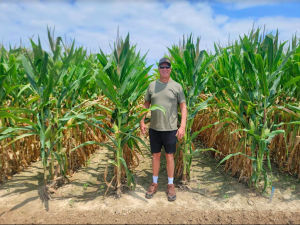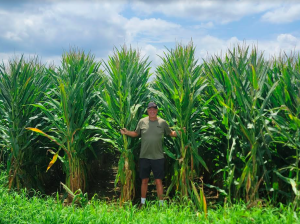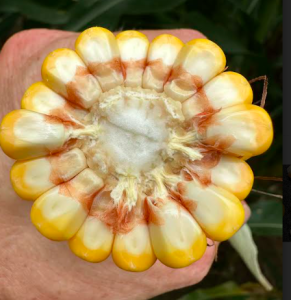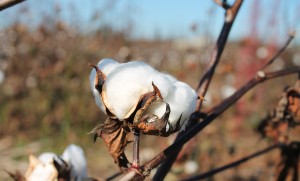Corn is made in July, soybeans are made in August.” That’s long been the belief of many farmers in the Midwest and much of the South. This is based on the reproductive stages of the various crops. For corn, pollination (tassel time), which usually takes place in early July, is the most critical phase in the plant’s life. I’ve seen mediocre-looking crops become bin-busters during a favorable pollination period. But I’ve never seen the opposite.
Many corn growers believe the crop is made once the calendar turns to August. This isn’t exactly true. Granted, there’s less of a financial motivation to invest in the crop during this time (especially this year, when commodity prices and borrowing ability are low). In my case this season, I still have about two weeks until physiological maturity. So, I could still see value from irrigating the crop (however, we have received nice rains, so my crop is in good shape). For soybeans, August is the time when they set and fill pods (plants may still flower in early August, too). Pods are very susceptible to abortion at this time. Soybeans tend to abort about 70% of their flowers and pods. So anything growers can do to reduce abortions can directly lead to greater yield. During this time soybeans are very susceptible to crop stress. August rains are celebrated in the Midwest, and irrigation pivots run where available. Now is when those yellow airplanes frequent rural skies. Insect pests can often become an issue, especially in dry years. In wet years, disease is an issue. Fungicides are often proactively applied to bolster plant health. Hormone balance is especially critical, so products that restore balance can be very beneficial. This is also a time to apply foliar fertilizers. Weeds still pose significant threats. Even in narrow rows, late-emerging weeds such as waterhemp and pigweed can rise above the crop canopy and create a yield drag. Such weeds are often resistant to glyphosate and other herbicides, which limits grower options. So while corn is heading to the finish line, wheat is in the bin and hay is a month away from the next cutting, soybeans must be scouted frequently and intensively managed during this time. All of which means that for soybeans growers, August is no time for an extended vacation.
Saturday is #NationalWatermelon Day! To quote Mark Twain: “When one has tasted watermelon, he knows what the angels eat.” Twain should know. He grew up along the Mississippi River, where the delectable green orbs flourish in those sandy soils. That makes sense, when you consider watermelons originated in the Egyptian desert. Watermelons also seem to love humic acid. Recent research at Tennessee State University revealed that melons grown with humic acid produced significantly higher fruit weights, moisture content and redness values. Three-quarters of the 3.4 billion pounds of the watermelon produced annually in the USA are grown in four states: Florida, Georgia, Texas and California. Growing up on the farm, nearly every mid-summer meal consisted of sweet corn and watermelon – with never any complaints! And none of it went to waste. After supper, it was my job to carry the leftover rines and cobs in buckets and throw them over the fence for the hogs. Upon seeing me walk toward the fence, they would stampede towards me. By the time I got back to the house, there was nothing left.
This season I’ve chronicled the progress of my corn. But you may be asking, how does it compare, size-wise, to other corn in the area? The photos below serve as a perspective. The first photo was taken of corn grown directly across the road from mine, the second is of mine. It is representative of most of the corn you see on the campus of Agricenter. I measured my corn over the weekend and it’s just over 10 feet tall. This is by far the tallest corn I’ve ever grown in Tennessee. It’s more reflective of what you see in Illinois.


At this point in my growing season, it’s all about kernel size. Here are two different ears, a “14” and “16”. Both are producing deep and big kernels. Kernels on the 14 are massive. This is the genetic expression of the hybrid. While the number of rows may be 14s or 16s, when managed right, the ears grow long and the kernels get very fat and heavy. That’s why it pays to feed and water the plant after tasseling. Lots of people get fixated on the number of kernels per ear. But in the end, farmers get paid on weight.


Related Posts

This Week in Ag #14
You never get a second chance to make a first impression. That popular saying could just as easily apply to planting corn. It’s impossible to recover from planting time mishaps. Don’t believe it? Try this. Walk into a cornfield where plants have recently emerged. Identify a plant that’s shorter than the rest (some call these

This Week in Ag #24
Yellow airplanes were buzzing over Iowa cornfields like bumblebees over zinnias during my drive to Iowa last week. There was a time when Midwest farmers would grind their teeth at the sight of these crop dusters. It usually meant a neighbor was treating a pest problem with a costly, unplanned aerial application. And that pest problem

This Week in Ag #34
Earl Butz, one of the most famous and popular US Secretaries of Agriculture, once told me that a key competitive advantage for US farmers in the global marketplace is our built-in natural infrastructure. Our Great Lakes and river system is perfectly designed to transport grain efficiently. The Mississippi River is the backbone of our agricultural transportation system: 60% of all grain exported from the USA is shipped by barge down the Mighty Mississippi.

